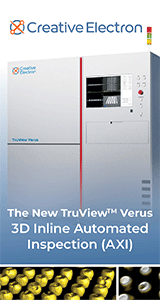|

|
Stencil Printing: Circular vs. Square Apertures
Production Floor |
|
Authored By:Chris Anglin, Ed Briggs Indium Corporation Clinton, New York USA SummaryIt is frequently noted in surface mount printed circuit board assembly that most solder defects can be traced back to the stencil printing process. In addition, continuous miniaturization trends for electronic components and challenge posed by smaller solder paste deposit requirement, increase focus on stencil printing. Hence, a pristine printer setup, precision tooling, proper squeegee length, stencil type, and stencil aperture design, have become vitally important because of miniaturization trends. To achieve successful stencil print performance, stencil aperture area ratio and print transfer efficiency are observed to be critical metrics to specify and control. Recent studies suggest that square aperture s provide better transfer efficiency than circular apertures, and the argument is raised that given the same area ratio, the volume provided by the square aperture is greater. This paper is a summary of best practices in optimizing the printing process focusing on comparison of large and small apertures, square vs. round, not with the same area ratio but with similar or the same volume. This paper will definitively clear the air on the round versus square aperture debate. ConclusionsResults between circular and square apertures with the same are all consistently close, and a there is slightly lesser amount of variation is achieved with square apertures, but square aperture volume tends to be about 25% less than circular apertures. In terms of transfer efficiency, square apertures tend to provide closer to 100% transfer efficiency (as area ratio increases from 0.63 to 1.00). Circular apertures are observed to provide greater than transfer efficiency than square aperture for similar aperture volume. A traditional aperture area ratio barrier (<0.66) can be crossed for both shapes, using setup approaches for detection of an unstable board support system. Acceptable variation for 0.30 mm pitch circular aperture, using a 4.0 mil stencil, could be expected to be exploited in production. Standard deviation in can be controlled so it does not exceed 0.31 nanoliters (19 cubic mil), offering an opportunity for a defect-free stencil print process for miniaturization. Process setup control shows acceptable variation for 0.80 mm pitch circular aperture, using a 4.0 mil stencil, where standard deviation does not exceed 96 cubic mil (1.60 nanoliters). These observations offer an opportunity for a defect-free stencil print process for fine pitch stencil printing and for precision stencil printing for miniaturized electronics assembly Alternate axis settings can enhance information transfer regarding tolerance level of variation in stencil print results. Using similar stencil thickness for larger apertures with similar volume, axis settings for transfer efficiency allows information to be easily observed. Converting to axis settings to cubic mil for larger and medium sized apertures with similar volume has been shown to be a useful unit for sharing results of print performance differences between circles and squares, especially acceptable tolerance for variation. Axis settings in nanoliters more clearly portray variation results at new low tolerance levels. Consequently, comparisons can be observed more clearly, allowing a more complete appreciation of new variation tolerance levels demanded by 0.3 mm pitch printing, and supporting a need for critical setup approaches. Initially Published in the IPC Proceedings |
|
Comments
|
|
|
|

|


